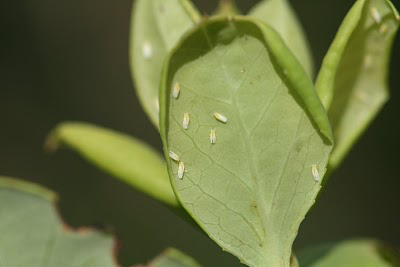Written By: Ash Sial, Blueberry Entomologist; James Jacobs, Pierce County CEC; and Zack Williams, Bacon County ANR agent
Over the past few years whiteflies have emerged as a major threat to several crops in Georgia and other states in the southeastern United States. In blueberries, whitefly populations typically increase after the end of harvest and continue to feed on the bushes through the fall until bushes drop foliage and this year in no different. Since the end of harvest, I have received several reports of whitefly infestations in blueberry fields in major blueberry producing counties in Georgia. In the past, we have identified heavy infestations of Tetraleurodes ursorum Cockerell (Aleyrodidae: Hemiptera). This species is sometimes called “bearberry whitefly” because it was first reported on the common bearberry (Arctostaphylos uva-ursi) on Flagstaff Mountain in Boulder, Colorado. However, there are several other species of whiteflies that are common in southeastern United States and can infest blueberries.
Bearberry whitefly pupae are oval, shiny black, about 0.7 mm (0.03 inch) long and 0.5 mm (0.02 inch) broad with a little white secretion around the base but no distinct fringe, and no dorsal secretion. Adults are about 1 mm (0.04 inch) long. The body from the above is blackish and covered with white mealy wax. The base and sides of the abdomen are white, the extreme base of wings yellow, and lower surface of the abdomen is light yellow with the last two segments gray. The eyes are black and completely divided, and the wings are white.
Whiteflies are related to scale and have a complex lifecycle. Eggs hatch to a mobile first instar, commonly known as crawlers. Once crawlers find a suitable location to feed and settle, they mature through a few stationary nymphal stages that feed to a final non-feeding nymphal instar, often called a pupa. The term pupa is a misnomer, a loose use of entomological nomenclature, because whiteflies do not truly develop through complete metamorphosis. Bearberry whiteflies colonize the underside of the blueberry leaves; the adults and eggs are commonly found on the lower surface of younger leaves whereas nymphal stages on somewhat older and mature leaves. Whiteflies have piercing-sucking (needle-like) mouthparts. They feed by inserting mouthparts into plant tissue and sucking the flowing sap or phloem. While feeding, they excrete a sweet, sticky liquid referred to as “honeydew”. Sometimes, they reach such high populations that cover the lower surface of the leaves with nymphs, pupae, and their associated honeydew. The honeydew excreted by nymphs can collect dust, lead to growth of sooty mold, and attract ants.

Bearberry whiteflies are primarily postharvest feeder and the prevalence of whitefly infestation in Georgia blueberries has significantly increased over the past couple of years. In most instances, infestations occur in small patches and do not seem to cause economic damage in blueberries. However, if high level of infestation is observed throughout the field, insecticide treatment may be needed to control this pest. An application of Admire Pro (via drip irrigation), Assail (foliar spray application) or Movento (foliar spray application) will help control this pest. When using insecticides, always read and follow the label instructions. Because whiteflies are small and feed on underside of the leaves, spray coverage is extremely important to control them. Thus, using high spray volumes (~80-100 gallons per acre) is highly recommended to achieve the desired level of spray coverage to control whiteflies.

